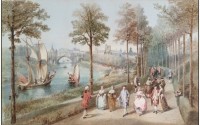A sense of place – the work of the graphic artist in York 1610-1860
- Date
- 15 Sep 2015
- Start time
- 7:30 PM
- Venue
- Tempest Anderson Hall
- Speaker
- Peter Brown

Peter Brown MBE
Former director, York Civic Trust
York has an exceptional built environment which offers, for those who look, evidence of nearly 2,000 years of occupation.
It is a composition and complexity which has fascinated artists for at least the last 400 years.
Some of its defining characteristics, the magnificent Gothic Minster rising imperiously above the roofscape, the long sections of medieval walls almost circumventing the central core, and the multifaceted pattern of medieval streets and historic buildings, combine to make Yorks physical appearance magnetically attractive and worthy of record.
Peter Browns illustrated talk draws heavily upon the many hundreds of paintings, drawings and engravings which form part of the Evelyn Collection at York Art Gallery. Also included are views from other collections, both private and public, which are featured in the presentation.
Many of the important panoramas are studied in detail, with the aim of exploring how accurate the artist has been and examining whether these details accord with other available evidence.
Local artists William Lodge and Francis Place, for example, whose watercolours and engravings are a rich source of study, provide us with a fascinating glimpse of how the city actually looked at the end of the late 17th century, whereas later works by the likes of Turner, Girtin and Cox evoke a more romantic sense of place, as seen through the artists eye.
Member’s report
Artists have been attracted to York for over 400 years, and while some views of the city were done from memory, increasingly they seem to have been done on the spot. Among prolific artists were William Lodge and Francis Place. The result is a huge collection of images which provide a detailed idea of how the city looked at different times particularly when combined with contemporary maps.
St Marys Abbey appears on John Speeds 1610 plan. Subsequent drawings and paintings show the decay of the ruins while Thomas Rowlandsons 1801 watercolour shows the Abbeys use as grazing land. Views of York from outside the walls show topographical details of buildings and sites now changed such as the roof on Cliffords tower. Nathaniel Whittocks 1858 Birds eye view over the city is remarkable for its topographical accuracy.
The Minster still dominates the citys skyline and naturally featured in many artworks over the four centuries. Changes to its immediate surroundings are particularly interesting. The attractive waterways and bridges of York also interested artists, and drawings sometimes provide information about lost springs, conduits and drains. They also show social changes, such as changes of land use, and the development of recreational riverside walks.
Carole Smith